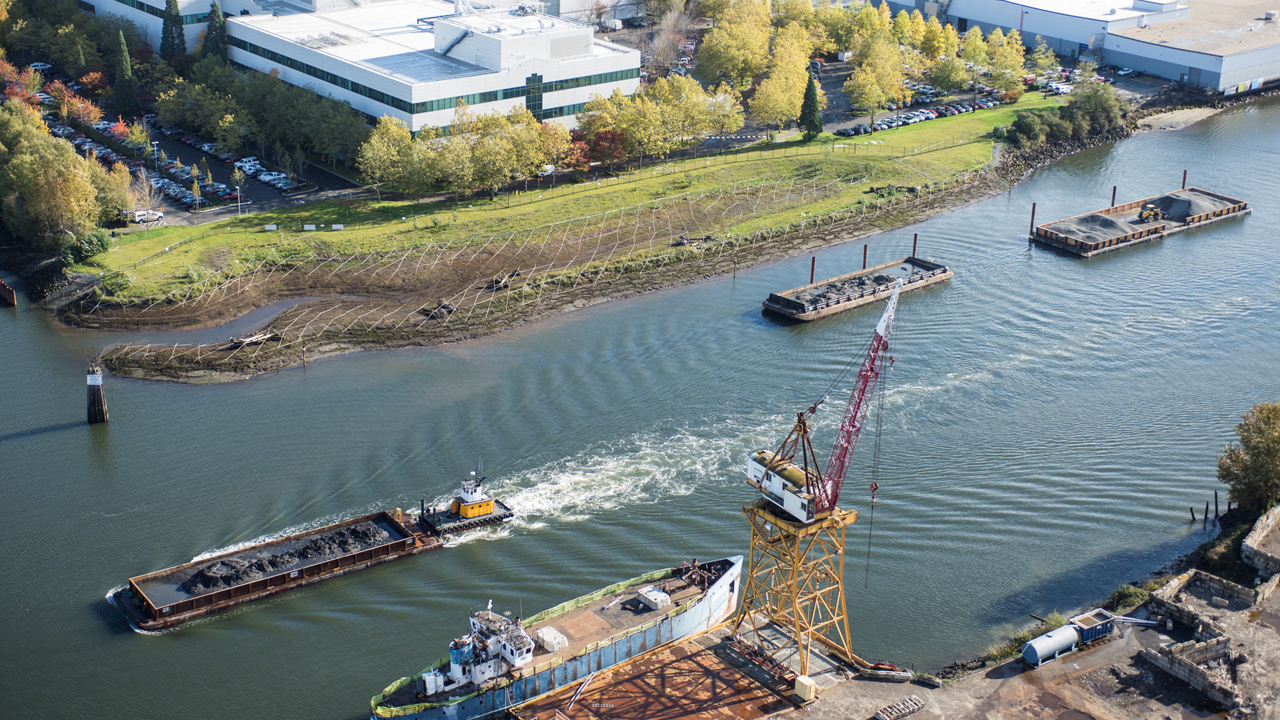For more than two decades, Boeing has demonstrated its commitment to the health of the Lower Duwamish Waterway and surrounding communities in Seattle, Wash., by investing in cleanup activities and habitat restoration. Boeing partners with businesses, tribes, the local community and government agencies, including the U.S. Environmental Protection Agency and the Washington Department of Ecology, to implement protective, timely and cost-effective cleanup solutions.
Restoring the Duwamish Waterway
What we’re working on
Construction kicked off in late November 2024 to clean up the five-mile Lower Duwamish Waterway Superfund Site as workers began removing contaminated sediment from the riverbed in the uppermost segment of the waterway. The City of Seattle, King County, and Boeing are working together to implement the multi-year cleanup of the entire waterway as members of the Lower Duwamish Waterway Group (LDWG).
Current progress
 Construction kicked off to clean up the five-mile Lower Duwamish Waterway Superfund Site in Seattle as workers began removing contaminated sediment from the riverbed in the uppermost segment of the waterway. (King County Department of Natural Resources and Parks photos)
Construction kicked off to clean up the five-mile Lower Duwamish Waterway Superfund Site in Seattle as workers began removing contaminated sediment from the riverbed in the uppermost segment of the waterway. (King County Department of Natural Resources and Parks photos)
 The City of Seattle, King County, and Boeing are working together to implement the multiyear cleanup of the entire waterway as members of the Lower Duwamish Waterway Group (LDWG). (King County Department of Natural Resources and Parks photos)
The City of Seattle, King County, and Boeing are working together to implement the multiyear cleanup of the entire waterway as members of the Lower Duwamish Waterway Group (LDWG). (King County Department of Natural Resources and Parks photos)
 Construction activities in the upper reach spans the southernmost two miles of the Superfund site. (King County Department of Natural Resources and Parks photos)
Construction activities in the upper reach spans the southernmost two miles of the Superfund site. (King County Department of Natural Resources and Parks photos)
Early action
The U.S. Environmental Protection Agency (EPA) declared this a Superfund Site in 2001. The agency is overseeing the cleanup design and construction for the waterway, and the Washington State Department of Ecology (Ecology) is the agency coordinating efforts to control sources of contamination from nearby upland areas along the 5-mile waterway. The in-water project will continue to improve water quality and reduce the risks sediment contamination presents to people and fish after more than a century of heavy industrial and commercial use.
In 2015, early actions cleaned up the most contaminated parts of the waterway and reduced sitewide PCB levels by half. The Lower Duwamish Waterway Superfund Site is divided into three segments (reaches) for sediment cleanup: upper, middle, and lower. Construction activities in the upper reach spans the southernmost two miles of the Superfund site.

Restoring Habitat for Fish and Wildlife
 2016 Enviro Report Plant 2 Duwamish Shoreline Restoration
2016 Enviro Report Plant 2 Duwamish Shoreline Restoration
Amid barges stacked high with containers set for Alaska and heaps of old appliances waiting to be recycled, there is now natural, undeveloped shoreline along this working waterway. Boeing is helping to restore the Lower Duwamish Waterway, transforming nearly one mile into a wetland resource that improves Puget Sound salmon runs.
From tufted hairgrass and bulrush to willows and big leaf maple, more than 170,000 native plants now occupy five acres along the water’s edge. These wetland plants and grasses, along with piles of woody debris that are anchored in place along the shoreline, provide refuge and food sources for fish and wildlife.
The National Oceanic and Atmospheric Administration recognized Boeing with its annual Excellence in Restoration award in 2015. This award honors leaders in coastal restoration who are focused on ecological value and the importance of effective collaboration with project partners.
The Natural Resource Trustees, a group that is made up of federal agencies, state agencies and local tribes, oversaw the project’s design. Boeing also worked with the U.S. EPA and the Washington State Department of Ecology to coordinate its waterway cleanup in conjunction with habitat restoration.
History of the Duwamish Waterway
Boeing can trace its nearly 100-year history back to the banks of the Lower Duwamish Waterway. In addition to supplying the U.S. military with nearly 7,000 B-17 bombers throughout World War II, Boeing Plant 2 provided thousands of Washington men and women with manufacturing and industrial jobs.
In December 2011, the aging 1.7 million square foot facility was demolished to clear the way for Boeing’s cleanup and habitat restoration efforts along the Lower Duwamish Waterway.
 The 5,000th B-17 bomber built after Pearl Harbor carried the signatures of all the builders, riveters and designers who worked on it at Boeing Plant 2.
The 5,000th B-17 bomber built after Pearl Harbor carried the signatures of all the builders, riveters and designers who worked on it at Boeing Plant 2.
